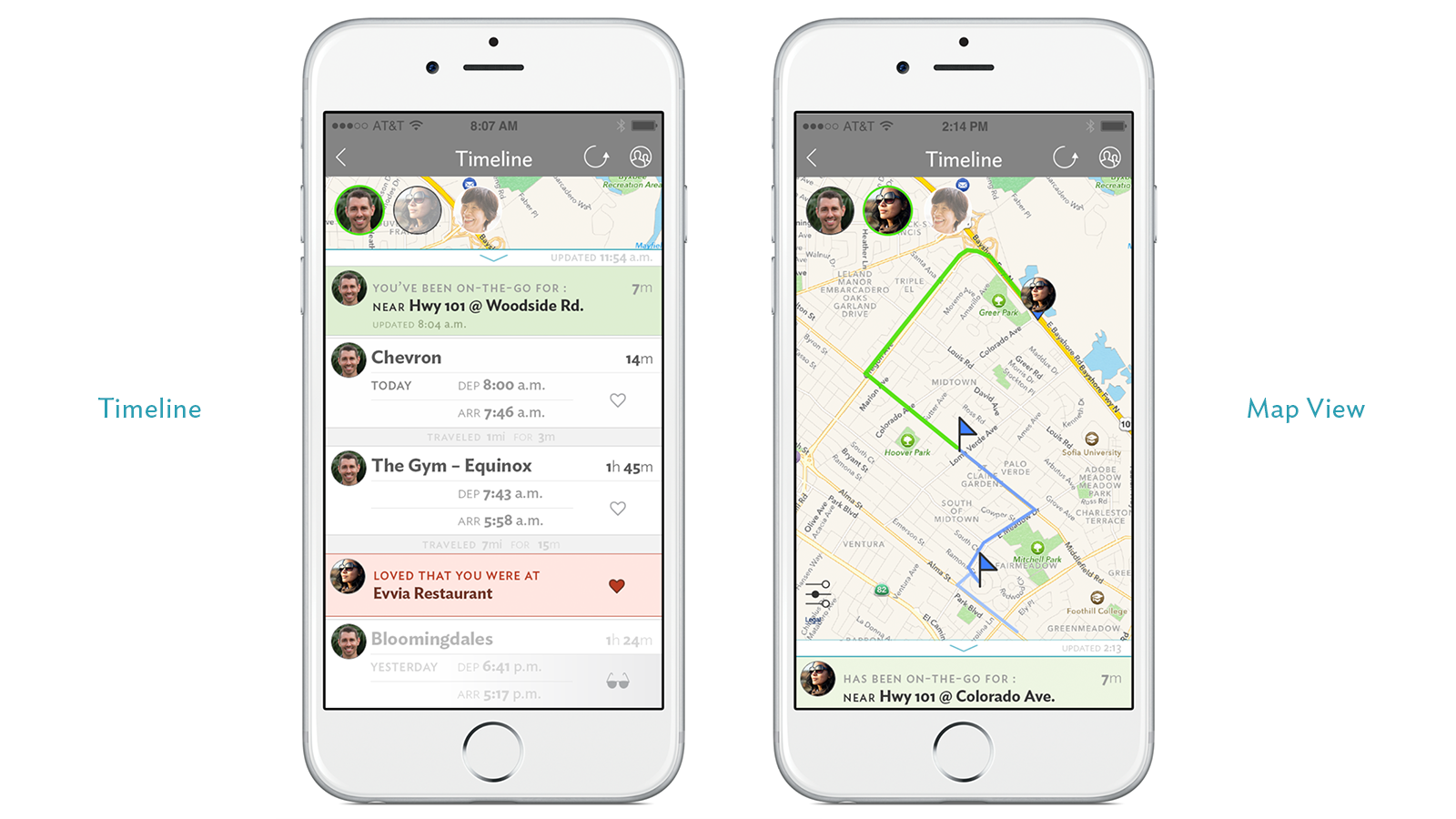PlaceUs
(acquired by Alibaba)A consumer location-sharing app that proved out geolocation place detection technology, and ultimately was introduced to 1.2 billion mobile users.

Company
PlaceUs founder Sam Liang was the lead engineer at Google who developed the “blue dot” on maps, and the algorithms behind it. He sought to bring this technology to consumers through the associated benefits of location sharing in a new consumer app for iOS and Android.
Challenge
1) Define a consumer audience for location sharing, 2) build a simple mobile app to make the complexity (both technical location detection and user behavior) of location-sharing easy, and 3) break down the stigma of a potential “stalker app”
Work Description
I led a team to define business model strategy and consumer audiences, redesign an app previously without any best practices applied in strategy nor visual/interaction design, and create a product experience that can be scaled.
Results
Through extensive user research and testing, we identified and validated that people DO want to share locations with one another: those almost exclusively in intimate relationships and caretakers of the elderly. We proved location-sharing technology can directly impact people’s lives by bringing them reduced stress, peace of mind, and insights of their own behavior.
Alibaba recognized the power of this technology, acquired PlaceUs and implemented its technologies in mobile-accessed websites with a reach of 1.2 billion users.
Details
 Strategy and Insights/Audience Segmentation We did extensive audience segmentation research, stakeholder interviews, current user surveys and interviews, and domain research for location-sharing and apps which people in relationships used. We uncovered incredible insights, mostly that people who trust each other WANT to share locations.
Strategy and Insights/Audience Segmentation We did extensive audience segmentation research, stakeholder interviews, current user surveys and interviews, and domain research for location-sharing and apps which people in relationships used. We uncovered incredible insights, mostly that people who trust each other WANT to share locations. Product Brand Experience / User Research An interesting strategic insight was the gender and sexuality has nothing to do with dynamics within couples that use the app to share locations. There is assertive and passive technology users, but in terms of strategy for the product brand and app experience a neutral approach was required—from color scheme to voice.
Product Brand Experience / User Research An interesting strategic insight was the gender and sexuality has nothing to do with dynamics within couples that use the app to share locations. There is assertive and passive technology users, but in terms of strategy for the product brand and app experience a neutral approach was required—from color scheme to voice. Rapid Protoyping/Interaction Design I optimized app experiences through rapidly creating wrireframes and making very rough prototypes. We also identified early-on where iOS and Android had different requirments, which saved time and resources. Agile-inspired process allowed us to go from rough prototypes to more refined ones for user testing.
Rapid Protoyping/Interaction Design I optimized app experiences through rapidly creating wrireframes and making very rough prototypes. We also identified early-on where iOS and Android had different requirments, which saved time and resources. Agile-inspired process allowed us to go from rough prototypes to more refined ones for user testing. Conversion/Acquisition First use after downloading the app was the biggest point of dropoff and attrition. We made the sign up flow effortless, and then used the interface to literally introduce itself, elminating “get started” overlays, help bubbles and irritating tutprials. With the flick of a gesture a person using the app could understand immediate value within seconds.
Conversion/Acquisition First use after downloading the app was the biggest point of dropoff and attrition. We made the sign up flow effortless, and then used the interface to literally introduce itself, elminating “get started” overlays, help bubbles and irritating tutprials. With the flick of a gesture a person using the app could understand immediate value within seconds. Service Design/Engagement Strategy Personal referrals and social engagement effortlessly formed the backbone of the PlaceUs experience. People were easily able to connect, and stay active in each other’s lives in meaningful ways. Further, user inputs made place detection more accurate, with the help of A.I. recommendations.
Service Design/Engagement Strategy Personal referrals and social engagement effortlessly formed the backbone of the PlaceUs experience. People were easily able to connect, and stay active in each other’s lives in meaningful ways. Further, user inputs made place detection more accurate, with the help of A.I. recommendations. 
Visual Design Language Visual design included color coding for easy recognition of location status (on-the-go vs. a stay at a location). Scanning a feed to understand information quickly was critical. We extensively tested and got real user feedback on readability for colors, type boldness and size, and placement of information—in both dim and sun-lit environments.

Service Design/Interaction Design The key screens of the app are a chronological timeline view as a feed, and a map view with paths and stays in locations marked clearly.

Profile Security/Human-centered Design One of the ways PlaceUs breaks the stigma of appearing as a “stalker app” is giving people detailed controls over keeping lcoation data private. While most people in intimate relationships have trust and actually WANT each other to know their lcoations, from time to time people want to switch into private mode. We found people most wanted privacy when doing something thoughtful, like holiday or birthday shopping.
Role
Alibaba/Alohar Mobile, Service Design Director
Participation
Product Design Direction and Hands-on Work
Abilities
Brand strategy, video, and identity; user research and usability testing; phased feature concepting; parallel interaction and visual design; thorough detailed design, extension, and production.